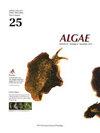Assessment of the macroalgal diversity of Kuwait by using the Germling Emergence Method
IF 2.4
3区 生物学
Q1 MARINE & FRESHWATER BIOLOGY
引用次数: 1
Abstract
Cryptic stages of diverse macroalgae present in natural substrata, “the bank of microscopic forms”, were isolated into clonal cultures and identified based on both morphological characteristics and DNA barcoding. Approximately 120 clonal isolates from 308 natural substratum samples were collected from the entire coastline of Kuwait. Amongst these isolates, 77 (64%) were identified through DNA barcoding using the nuclear ribosomal small subunit, RuBisCO spacer (ITS2, tufa, rbcL, psaA, and psbA) and sequencing. Twenty-six isolates (34%) were identified in the division Chlorophyta, 18 (23%) as Phaeophyceae, and 33 (43%) as Rhodophyta. For all DNA sequences in this study, species-level cut off applied was ≥98% homology which depend entirely on the markers used. Three putative new records of Chlorophyta new for the Arabian Gulf were made: Cladophora laetevirens (Dillwyn) Kützing, Ulva torta (Mertens) Trevisan and Ulvella leptochaete (Huber) R. Nielsen, C. J. O′Kelly & B. Wysor in Nielsen, while Cladophora gracilis Kützing and Ulva ohnoi M. Hiraoka & S. Shimada are new records for Kuwait. For Phaeophyceae, Ectocarpus subulatus Kützing and Elachista stellaris Areschoug were new records for the Gulf and Kuwait. In the Rhodophyta, Acrochaetium secundatum (Lyngbye) Nägeli in Nägeli & Cramer, Ceramium affine Setchell & N. L. Gardner, Gelidium pusillum var. pakistanicum Afaq-Husain & Shameel and Dasya caraibica Børgesen are new records for the Gulf and Kuwait, while the red alga Stylonema alsidii (Zanardini) K. Drew is a new record for Kuwait. Several isolates identified corresponded to genera not previously reported in Kuwait and / or the Arabian Gulf, such as Porphyrostromium Trevisan, a new genus from the Bangiales, and two unidentified species for the Planophilaceae Škaloud & Leliaert. The isolates cultivated from substrata enhance understanding of the marine macroalgal diversity in the region and confirmed that the Germling Emergence Method is suitable for determining the actual diversity of a given study area through isolation from cryptic life-history phases.用萌芽出现法评估科威特大型藻类多样性
将存在于天然基质中的各种大型藻类的隐生阶段(“微观形态库”)分离到克隆培养中,并根据形态特征和DNA条形码进行鉴定。从科威特整个海岸线的308份天然基质样品中收集了大约120株克隆分离株。其中77株(64%)通过核糖体小亚基、RuBisCO间隔区(ITS2、tufa、rbcL、psaA和psbA)的DNA编码和测序鉴定。绿藻门26株(34%),褐藻门18株(23%),红藻门33株(43%)。对于本研究中所有的DNA序列,所应用的物种水平切断具有≥98%的同源性,这完全取决于所使用的标记。阿拉伯湾的绿藻新记录为Cladophora laetevirens (Dillwyn) k tzing, Ulva torta (Mertens) Trevisan和Ulvella leptochaete (Huber) R. Nielsen, C. J. O 'Kelly & B. Wysor,科威特的Cladophora gracilis k tzing和Ulva ohnoi M. hiroka & S. Shimada。褐生科的Ectocarpus subullatus k tzing和Elachista stellaris Areschoug是海湾和科威特的新记录。在红藻门中,Nägeli & Cramer的Acrochaetium secundatum (Lyngbye) Nägeli、仿射的Ceramium Setchell & N. L. Gardner、Gelidium pusillum ar. pakanicum Afaq-Husain & Shameel和Dasya caraibica Børgesen是海湾和科威特的新纪录,而红藻Stylonema alsidii (Zanardini) K. Drew是科威特的新纪录。已鉴定的几个分离株对应于科威特和/或阿拉伯海湾以前未报道的属,例如来自Bangiales的新属Porphyrostromium Trevisan,以及Planophilaceae Škaloud和Leliaert的两个未识别种。从基质中培养的分离物增强了对该地区海洋大型藻类多样性的认识,并证实了生殖涌现法适用于通过从隐生活史阶段分离来确定给定研究区域的实际多样性。
本文章由计算机程序翻译,如有差异,请以英文原文为准。
求助全文
约1分钟内获得全文
求助全文
来源期刊

Algae
PLANT SCIENCES-
CiteScore
5.10
自引率
25.00%
发文量
18
期刊介绍:
ALGAE is published by the Korean Society of Phycology and provides prompt publication of original works on phycology. ALGAE publishes articles on all aspects of phylogenetics and taxonomy, ecology and population biology, physiology and biochemistry, cell and molecular biology, and biotechnology and applied phycology. Checklists or equivalent manu-scripts may be considered for publication only if they contribute original information on taxonomy (e.g., new combinations), ecology or biogeography of more than just local relevance. Contributions may take the form of Original Research Articles, Research Notes, Review Articles and Book Reviews.
 求助内容:
求助内容: 应助结果提醒方式:
应助结果提醒方式:


